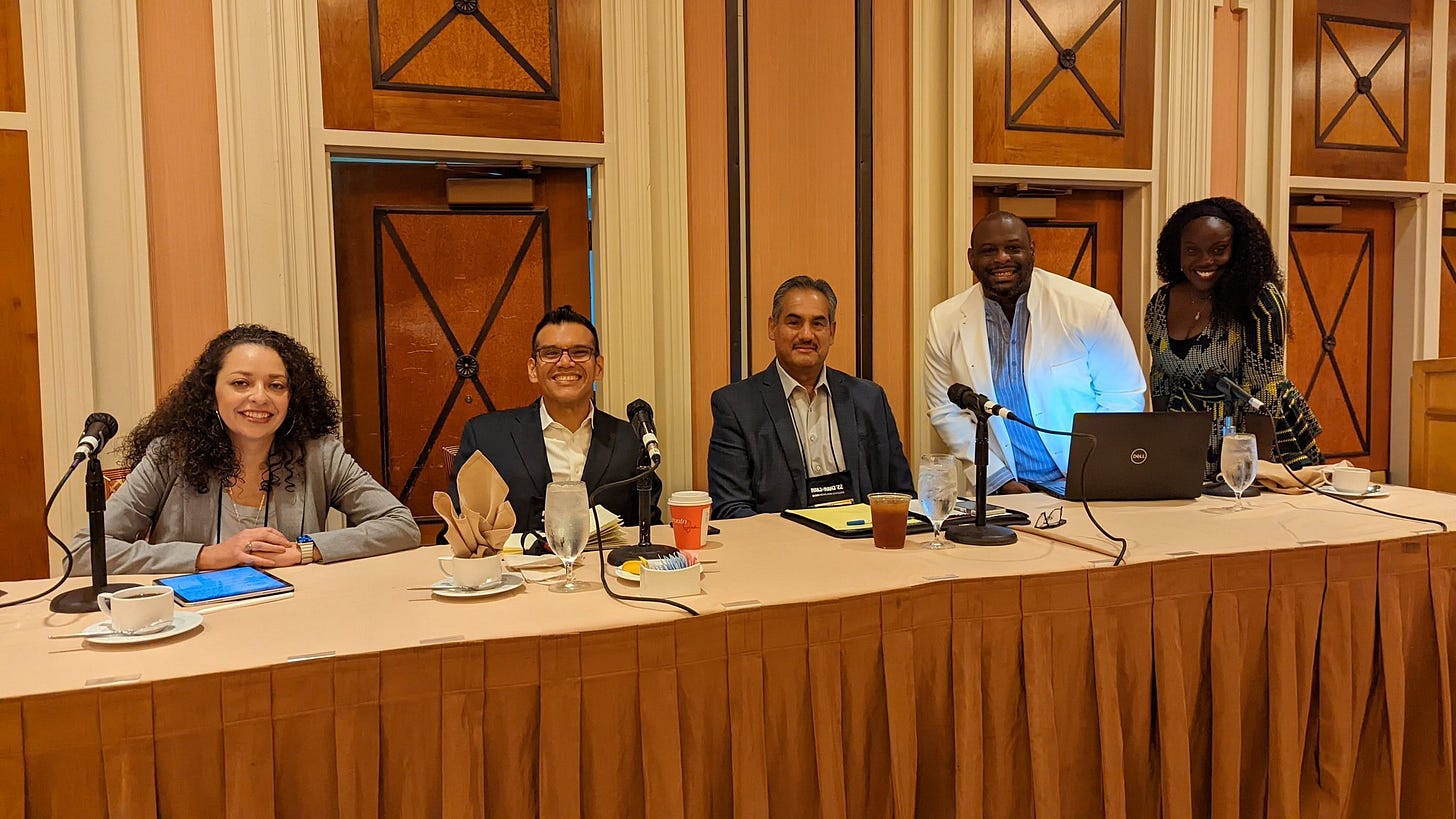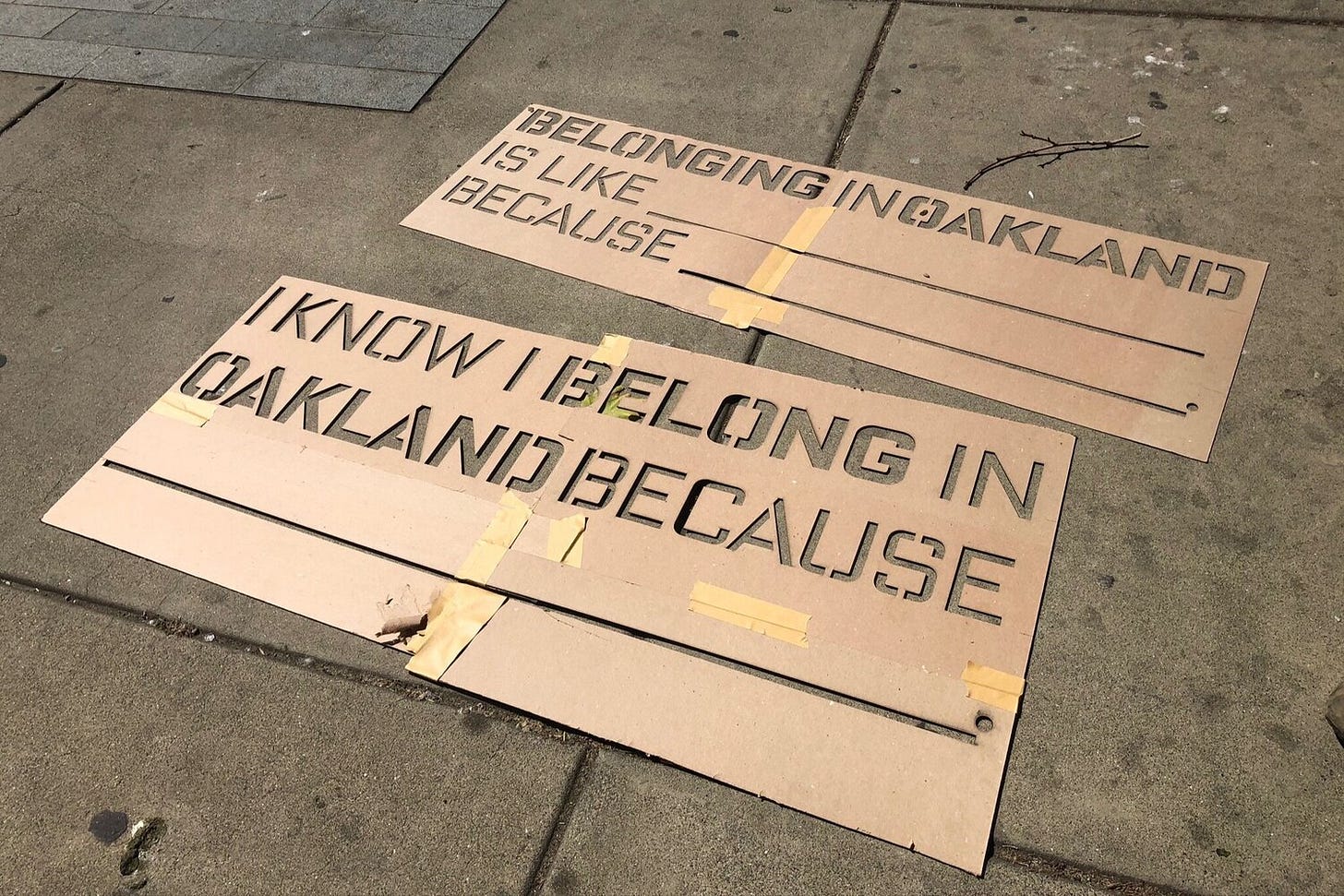Our future depends on belonging and trust
Public media challenges with Latina/o/e/x engagement lie in showing up
At this writing, I am attending the joint convention of the National Association of Hispanic Journalists and National Association of Black Journalists. Many of the journalists in attendance have deep roots in the communities they cover. A topic all are grappling with sounds familiar. It is identical to one we’re facing in public media.
Trust.
You have heard so much about polarization. 💀 You’ve also read about perceptions of news coverage. Such tensions belie a troubling matter.
While there are partisan feelings aplenty, a malaise is widespread. 😬
The number of Americans who trust journalism is at its smallest figure in years.
Already, Americans as a whole feel reporting can be one-sided.
They further think it takes political positions.
Pew suggests the public’s feelings about this may not be far off, either. Journalists clash with the public’s viewpoints about the work.
(I do not seek to rehash the discussion about what’s a ‘side’ versus what’s truth, or objectivity. These issues are less the point that how media differs with the public on what matters. More later.)
Items farthest apart were what the respondents discussed that other group didn’t. Image credit: Reuters Institute
Among Black and Latina/o/e/x Americans, lower numbers have been persistent for some time. There are many factors to such distrust. ☑️
Top of the list? Journalism’s sorry record covering communities of color over the last 100 years.
We’ve also not succeeded at explaining what journalism does and why. Reactions from residents in Uvalde are the latest instance of that gap.
As far as the bigger picture, journalism approaches demand attention. As Mutale Nkonde reminds us, how language and processes are racially coded with white as the default requires vigilance. 🗒️
The good news is that Americans generally find noncommercial media more trustworthy than the commercial press. In fact, they feel that we’ve done a good job covering specific topics. But how can we continue to build on those good feelings? For public media, how can we build on those relationships long term?
In Vegas, the investigation is about the audience, how they feel about us, and how we may help them feel a sense of trust.
At The Color of Public Media: Leadership Edition breakfast panel with Vanessa de la Torre, Gilbert Bailon, Lee Hill and Yemisi Oloruntola-Coates.
I promised this OIGO to cover the subject of belonging. 🌐 Central to trust is feeling a sense of belonging. If someone feels like they’re included as a part of something — a community, a dialogue, an exchange of ideas — they’re more likely to be invested. People who are invested are more inclined to engage, or not silo off.
The Corporation for Public Broadcasting has been a champion of initiatives where belonging is implicitly part of the mission. 🗻 CPB has also boosted organizations in polarized communities. Their engagement can’t be underestimated.
Credit due: Groups like Gather, Hearken and America Amplified have sparked provocative conversations over the years. In addition, journalism itself has discussed how we got to such a pernicious place in the culture.
What are we learning?
Belonging has roots in how we understand ourselves and one another. The graphic above? It’s from the Reuters Institute. It shared a striking study last year on trust in media. ⏏️ Newsgathering and decision-making processes rarely come up for the public, for instance.
And also, that trust is built on how well you know them, and they you.
The theme of knowing people and letting them in has been a common thread in many past OIGO profiles. If you’re in public media, and a Latina/o/e/x community has never traditionally been on your radar, helping them feel like they belong and that you know them are foundational to your relationship
If your organization is discussing growth, delving into the issue of belonging will help you immensely. 👇🏼
Susie Wise notes fostering feelings of belonging can be organizational imperatives. Her book, Design for Belonging, has a toolkit you might find helpful. Among the exercises she recommends include asking what words or feelings are associated with belonging. For instance, you may think of places you feel belonging, and where you don’t, and then defining why. What was the journey to get there? Noticing and understanding these moments, Wise says, is crucial for belonging.
Brevity & Wit’s Define and Diagnose model 🩹 offers a similar framework that works like this:
Define equitable outcomes
Define observable behaviors
Diagnose barriers to behavior adoption
Along with Brené Brown, a name you’ll see on the path to understand belonging is Peter Block. His book, Community: The Structure of Belonging, is one of the better known works in this space. 📚 Block says six conversations are essential.
Invitation: inviting people to take part
Possibility: leading with more than your goals, but by what is possible
Ownership: how can they be involved and accountable to a community
Dissent: embracing doubt and reservations
Commitment: what promises can we ask of our community
Gifts: Building from strengths rather than focusing on deficiencies
From here, one sees how belonging comes about for people. Then, you can start shaping experiences that spark belonging. ✨
Image credit: Design for Belonging
Three cases may help in thinking about belonging. 📂 I like going outside of public media. This is in part because we can learn a great deal from other nonprofit sectors.
Caregiving to children and seniors may provide public media with the most compassionate ways to consider belonging. We’re not caregivers, nor do I aim to diminish the hard work of caregiving. Yet for some, and in our community, we offer intellectual and emotional support and stability in a confusing world. 💙 This study on caregivers and social connection may make you rethink how public media can contribute to individual and collective well-being. How people feel support may correlate with feelings of isolation. And our own strain can trickle down to how we show up in our community.
Museums do what public media aspires to do: be a gathering place and a conversation starter. 🖼️ Museums have mastered our ambition to be valued by people of many persuasions.
Museums Fostering Belonging is a cohort devoted to being that way. A theme that comes up again and again is: how do we help others from feeling alone or isolated? I don’t think that’s a situation we think of or try to solve in our public gatherings, volunteer systems, or even on-air presentation. By the way, the group’s Audiences and Inclusion primer implores leaders to go deeper when it comes to trust. Values, attitudes, beliefs and even curiosity and emotions shape people's perceptions.
The Ohio Department of Job and Family Services sought to understand how racism is experienced in the state’s children services system. 🚸 To do so, coordinators engaged in deep listening sessions to understand the needs of those in the system, as well as caseworkers.
The findings included a lack of preparation among foster parents and gaps for youth aging out of the system. Involving children and families in policy decisions and planning was also incorporated into the infrastructure.
Minal Bopaiah (who many caught at the Public Media Development and Marketing Conference last month) wrote that trust rests in paradox. 🤨 Creating high-trust environments in public media means transparency must be paired with boundaries. In a world where boundaries may be interpreted as obfuscation, however, trust internally can be a challenge. In connecting with communities, fostering trust and belonging will remain a process.
In Vegas, the conversation on belonging in media is ongoing. As it should. 🟢
La próxima ⌛
The next OIGO is in your inbox September 9. I want to take a moment to plug the OIGO Reader Survey. ✅ I want to better understand your needs. One respondent will be drawn for a gift, and you have a good shot at winning. Thanks for your help!
-- Ernesto
Cafecito: stories to discuss ☕
Two journalists who fled gangs in Mexico have called on President Biden to ensure funds to protect journalists are being used for such. 💸
Conversations about race a the trend everywhere, including public media. Willie Randall asks if these dialogues create justice. Too often, Randall remarks, people of color open up, but the response of whites is to sit there. 🤔
A community station’s Latin music program lands another writeup about the show. 🎙️ For a small station’s one program to get a story is unusual, but this one also got other media coverage in October. You’ve got to respect the hustle.
El radar: try this 📡
Rethink translations. 🐱💻 Public media has turned to Spanish translations to attract Hispanics, but with mixed success. In South Carolina, Nuestro Estado gained audiences through translations on hurricanes and the coronavirus. How did they succeed where others have not? Better News explores the model.
Or consider indigenous languages. A news organization in Chihuahua, Mexico is seeking to serve indigenous residents. 🖊️ Its solution? To offer podcasts in Spanish and the Rarámuri language. “[E]ven though there are areas with no internet, there are others where they can easily access WhatsApp,” explains an editor for Raíchali Noticias in a report for Nieman Lab. “That’s why we decided to do a podcast.”
Ask how parents are filling the bilingual education gap. 🍏 There’s a national shortage of teachers who speak Spanish. WFAE reports on a district recruiting parents to help schools. Is this happening in your community too?
Find locals who moved to Mexico. A growing number of Americans are moving to Mexico City and other areas south of the border. Locals are fed up. 😠 How do people who used to live near you reconciling the impact they’re having on Mexico?
See how climate change is hurting your state’s farming. 🌾 WUSF’s coverage on how climate change is affecting farmworkers’ livelihoods and health is a must read. It’s available also in Spanish. The story behind the year it took to build the coverage is conveyed at America Amplified.
☕ You can buy me a coffee if you’d like to support the newsletter.










